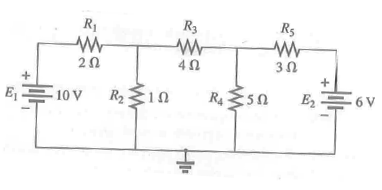
Concept explainers
For the network in Fig. 8.121:
a. Write the equations necessary to solve for the branch currents.
b. By substitution of Kirchhoff’s current law, reduce the set to three equations.
c. Rewrite the equations in a format that can be solved using third-order determinants.
d. Solve for the branch current through the resistor

Fig. 8.121
Want to see the full answer?
Check out a sample textbook solution
Chapter 8 Solutions
Introductory Circuit Analysis; Laboratory Manual For Introductory Circuit Analysis Format: Kit/package/shrinkwrap
Additional Engineering Textbook Solutions
Thermodynamics: An Engineering Approach
Vector Mechanics For Engineers
Vector Mechanics for Engineers: Statics and Dynamics
Fluid Mechanics: Fundamentals and Applications
Elementary Surveying: An Introduction To Geomatics (15th Edition)
Starting Out with Programming Logic and Design (5th Edition) (What's New in Computer Science)
- Maul Dulde Questio119 819 PREV NEXT In the lab, you have setup a thermocouple and have used a thermistor along with an ice bath and water at various temperatures (confirmed with the thermistor) up to 100 degrees Celsius for calibration. The calibration data is shown in the table below and the full-scale output range is 0-5 mV. You note that there is scatter in your data; however, you must use a linear curve fit to efficiently process the measurements during an automated temperature measurement process. Question 1 100% Question 2 100% Question 3 100% Question 4 100% Question 5 100% Question 6 100% mV The slope of your linear calibration curve for the thermocouple is 0.0334 °C with an offset of -0.07 mV. Question 7 100% Question 8 100% What is the maximum expected linearity error as a percentage of the full-scale output? Question 9 0% Summary -0.08 Thermocouple Calibration Data Temperature (°C) Voltage (in mV) 0 20 20 40 40 60 60 60 80 96 90 0.587 1.314 1.901 2.528 2.782 100 3.055 LIT…arrow_forwardOnly expert should solve itarrow_forwardWhat is the high cutoff frequency? What is the low cutoff frequency? What is the bandwidth?arrow_forward
- Need handwritten pen and paper solution do not use chatgpt or AI otherwise downvote. An AC motor with impedance Z₁ = 4.2 + j3.6 ohm is supplied from a source of 220 V at 60 Hz. Find: a) pf, P and Q, b) Determine the capacitor required to connect in parallel with the motor so that the power factor is corrected and equal to 0.98 behind.arrow_forwardNeed handwritten pen and paper solution do not use chatgpt or AI otherwise downvote An AC motor with impedance Z₁ = 4.2 + j3.6 ohm is supplied from a source of 220 V at 60 Hz. Find: a) pf, P and Q, b) Determine the capacitor required to connect in parallel with the motor so that the power factor is corrected and equal to 0.98 behind.arrow_forwardFind;- magnitude of line voltages Line currents Verify that th eload is balanced, i.e In = 0arrow_forward
- Don't use ai to answer I will report you answerarrow_forwardDon't use ai to answer I will report you answerarrow_forward(b) Below is a FSM with a 1-bit input A, and a 1-bit output Y. Deter- mine the combined state and output table. Identify the unreachable states, and sketch the state-transition diagram. In your table and diagram, use Os and 1s for the states and next states, not symbols like S0, S1, etc. A D D D CLK S'₁₂ S2 S₁₁ S1 Y S' r So S2 S₁ So resetarrow_forward
- Do by pen and paper not using chatgpt Determine the output current of E1 in the circuit shown in . The voltage drop of the diodes is 0.7 V.arrow_forwardDon't use ai to answer I will report you answerarrow_forwardFor the amplifier shown, if β = 150: Calculate the input impedance at the base. Calculate the input impedance of the stage.arrow_forward
 Delmar's Standard Textbook Of ElectricityElectrical EngineeringISBN:9781337900348Author:Stephen L. HermanPublisher:Cengage Learning
Delmar's Standard Textbook Of ElectricityElectrical EngineeringISBN:9781337900348Author:Stephen L. HermanPublisher:Cengage Learning
